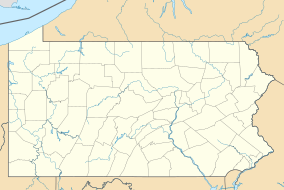| Hoverter and Sholl Box Huckleberry Natural Area | |
|---|---|
  | |
| Location | Perry County, Pennsylvania |
| Nearest town | New Bloomfield |
| Coordinates | 40°24′22″N 77°10′26″W / 40.40611°N 77.17389°W / 40.40611; -77.17389 |
| Area | 10 acres (4.0 ha) |
| U.S. National Natural Landmark | |
| Designated | 1967 |
Hoverter and Sholl Box Huckleberry Natural Area is a 10-acre (4.0 ha) natural area in Perry County, Pennsylvania, near New Bloomfield, which protects a colony of box huckleberry over 1,000 years old. The smallest Natural Area in Pennsylvania, it is administered as part of Tuscarora State Forest. It was designated a National Natural Landmark in April 1967.
Topography
A 0.25-mile (0.40 km) path forms a loop around the site, which is located on the west side of a hill slope. Twenty-seven interpretive stations are located along the trail. In addition to the low growth of the box huckleberry itself, the hillside is covered with white pine and oak forest, with a scattering of other trees and various wildflowers.
History
The specimen of box huckleberry at the natural area has been estimated, based on its observed rate of growth and clonal reproduction, to be 1,200 to 1,300 years old, only a tenth of the estimated age for a nearby colony at Losh Run. The colony was discovered by Spencer Baird in 1845. No specimens of box huckleberry had been collected since 1805, and Baird's discovery allowed Asa Gray to classify the species as Gaylussacia brachycera. The resulting correspondence sparked a lifelong friendship between the two, and helped Baird attain a post at the Smithsonian Institution.
The box huckleberry remained largely obscure until 1918, when Frederick V. Coville examined the site. On the basis of his observations there, he concluded that box huckleberry was self-sterile and spread clonally. After commercial nurserymen removed a truckload of plants from the site, Coville called attention to its plight with an article in Science. Renewed interest sparked the discovery of other box huckleberry colonies elsewhere in the Appalachians.
The New Bloomfield site was first protected with the donation of 4 acres (1.6 ha) to the state in 1929, the beginning of the Natural Area.
References
- ^ Crable, Ad (1999-08-20). "Meet The World's Oldest--and Hardest Working--Plant". Lancaster New Era. Archived from the original on 2008-05-29. Retrieved 2008-06-22.
- ^ "Tuscarora State Forest Natural Areas". Pennsylvania Department of Conservation and Natural Resources. Archived from the original on February 26, 2004. Retrieved 2008-08-13.
- ^ Fergus, Charles; Rae, Rusty (January 2002). Natural Pennsylvania: Exploring the State Forest Natural Areas. Stackpole Books. p. 48. ISBN 978-0-8117-2038-0.
- "Box Huckleberry Site". nps.gov. National Park Service. Archived from the original on 2013-03-08. Retrieved 2013-03-30.
- ^ Coville, Frederick V. (1919-07-11). "The Threatened Extinction of the Box Huckleberry, Gaylussacia brachycera". Science. 50 (1280): 30–34. doi:10.1126/science.50.1280.30. JSTOR 1641999. PMID 17801660. Archived from the original on 2021-05-09. Retrieved 2019-07-06.
- Wherry, Edgar T. (June 1972). "Box-Huckleberry as the Oldest Living Protoplasm". Castanea. 37 (2). Southern Appalachian Botanical Society: 94–95. JSTOR 4032456.
- Smith, Hazel; Smith, Don (June 1971). "The Box Huckleberry, Gaylussacia brachycera". Castanea. 36 (2). Southern Appalachian Botanical Society: 81–89. JSTOR 4032308.
- Pooler, Margaret; Nicholson, Rob; Vandegrift, Andrew (2008). "Clonal Fidelity in Large Colonies of Gaylussacia brachycera Gray (Box Huckleberry) Assessed by DNA Fingerprinting". Northeastern Naturalist. 15: 67–74. doi:10.1656/1092-6194(2008)15[67:CFILCO]2.0.CO;2. ISSN 1092-6194. Retrieved 2008-06-21.
- Wherry, Edgar T. (February 1934). "The box huckleberry as an illustration of the need for fieldwork". Bulletin of the Torrey Botanical Club. 61 (2). Torrey Botanical Society: 81–84. doi:10.2307/2480787. JSTOR 2480787.
External links
- Natural & Wild Areas of the Tuscarora State Forest, Pennsylvania Department of Conservation and Natural Resources
| National Natural Landmarks in Pennsylvania | |
|---|---|
| |
| List of National Natural Landmarks in Pennsylvania |